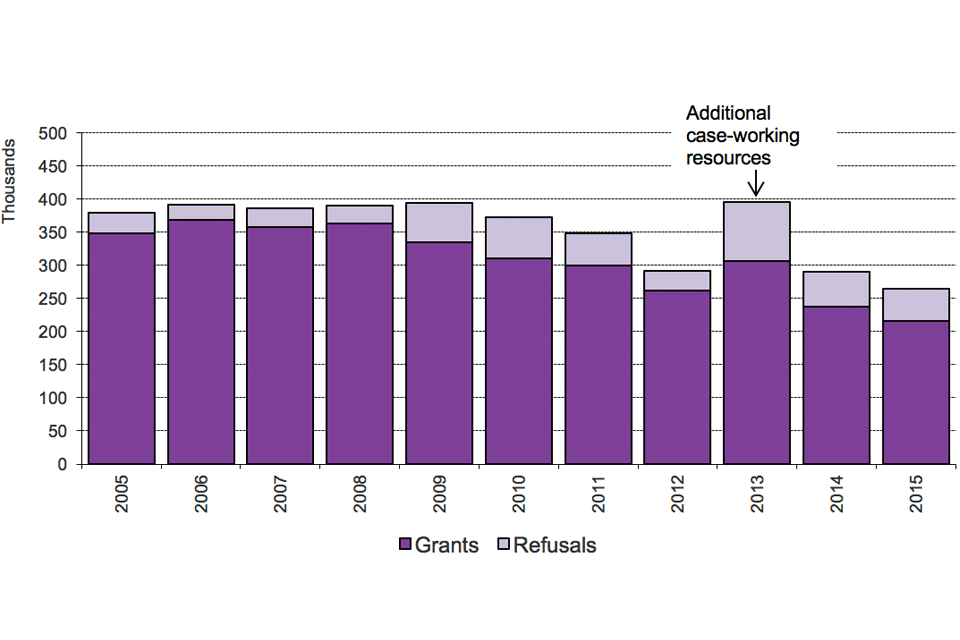Extensions of stay
Updated 3 March 2016
Valid: 25 February 2016 to 25 May 2016
Data relate to the calendar year 2015 and all comparisons are with the calendar year 2014, unless indicated otherwise.
Back to ‘Immigration statistics October to December 2015’ content page.
This is not the latest release. View latest release.
1.Key facts
There were 264,450 decisions on extensions in 2015, 9% fewer than in 2014. Four-fifths of decisions were grants (215,781) and a fifth (48,669) were refusals.
There were 80,217 work-related grants of extensions in 2015, 9% lower than in 2014 (88,404). There was a 3% fall for Tier 2 Skilled Work (to 59,280), a fall of 61% for Tier 1 Entrepreneurs (to 2,813) following tightening of rules to prevent abuse, and a fall of 36% in the Tier 1 General category (to 5,260) reflecting its previous closure to new entrants.
Study-related grants of extensions fell by a fifth (-20%) to 63,473 in 2015, likely reflecting falling numbers of study visas from 2010 to 2013 and tighter rules such as the new use of the “genuineness” test. For further details see the study topic.
Family-related grants of extensions increased by 22% (+8,110 to 44,744) in 2015. This was largely accounted for by a 6,174 increase in grants to partners (to 25,378). The 6,174 increase likely reflected both a longer residence eligibility period before it is possible to apply to stay in the UK permanently (settlement), and a requirement to obtain an extension after two and a half years, under new family rules implemented from 9 July 2012. Grants in the Family Life (10-year) category rose by 1,966 (to 19,307).
There were 48,669 refusals of an extension in 2015 of which 6,758 related to work, 9,925 to study, 14,917 to family and 17,069 to other categories. Correspondingly the refusal rates for work, study, family and other categories were 8%, 14%, 25% and 38% respectively.
2.Grants of extensions by reason, and refusals
| Year | Total decisions | Total grants | Work | Study | Family (1) | Other (1) | Refusals |
| 2011 | 347,637 | 299,600 | 134,377 | 119,303 | 17,189 | 28,731 | 48,037 |
| 2012 | 291,827 | 261,810 | 140,947 | 87,073 | 16,627 | 17,163 | 30,017 |
| 2013 | 394,592 | 306,598 | 122,463 | 117,810 | 40,434 | 25,891 | 87,994 |
| 2014 | 290,377 | 236,740 | 88,404 | 79,778 | 36,634 | 31,924 | 53,637 |
| 2015 | 264,450 | 215,781 | 80,217 | 63,473 | 44,744 | 27,347 | 48,669 |
| Change: latest 12 months | -25,927 | -20,959 | -8,187 | -16,305 | +8,110 | -4,577 | -4,968 |
| Percentage change | -9% | -9% | -9% | -20% | +22% | -14% | -9% |
Table notes
Source: Home Office, Immigration Statistics October to December 2015, Extensions table ex 01 q.
(1) The introduction of the new Family Life (10-year) route in July 2012 ‘Statement of intent: Family migration’ means that the total number of Family and Other grants are not fully comparable over time.
3.Long-term trends in grants and refusals of extensions of stay
The chart below illustrates longer-term trends in grants and refusals to extend stay by calendar year back to 2005.

The
Chart notes
Source: Home Office, Immigration Statistics October to December 2015, Extensions table ex 01.
4.Nationalities granted an extension
(excludes dependants)
Data for grants by nationality in 2015 are planned to be published in Immigration Statistics January to March 2016, due to be released on 26 May 2016.
Top 5 nationalities granted an extension to stay, 2014
(Total number of grants 179,033, excludes dependants)

The
Chart notes
Source: Home Office, Immigration Statistics October to December 2015, Extensions table ex 02.
5.Data tables
Further data on extensions are available in Extensions tables ex 01 to expc 01 o.
More detailed analysis on family extensions and additional tables for years ending June were included in the Immigration Statistics April to June 2015 release Family topic to assist users in understanding the trends before and after the changes to the Family Immigration Rules in July 2012.
A short statistical article on ‘Extensions of stay by previous category’ was published alongside the Immigration Statistics April to June 2013 release to provide further detailed information. Updates of the more detailed tables provided in the article are included in the Extensions tables.
6.Background information
The figures in this section relate to individuals inside the UK extending or changing the status of their stay in the UK. Data include dependants unless stated otherwise.
The numbers reflect past changes in the levels of those entering the UK in different categories, policy and legislative changes, e.g. closure of categories or changes to the length of visas granted to people entering the UK, or to the rules on whether individuals can switch categories. The figures also may reflect the level of case-working resources available.
Migration Transparency Data webpage A range of key input and impact indicators are currently published by the Home Office on the Migration Transparency Data webpage.
Staying in the UK In January 2016 the Home Office published its ‘Migrant Journey: Sixth Report’, which shows how non-EEA migrants change their immigration status or achieve settlement in the UK.
